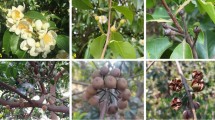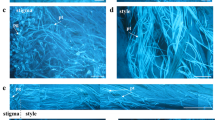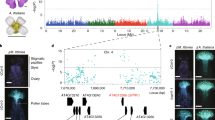Abstract
In higher plants, sexual reproduction involves interactions between pollen and pistil. A key mechanism to prevent inbreeding is self-incompatibility through rejection of incompatible (‘self’) pollen1. In Papaver rhoeas, S proteins encoded by the stigma interact with incompatible pollen, triggering a Ca2+-dependent signalling network2,3,4,5 resulting in pollen tube inhibition and programmed cell death6. The cytosolic phosphoprotein p26.1, which has been identified in incompatible pollen, shows rapid, self-incompatibility-induced Ca2+-dependent hyperphosphorylation in vivo3. Here we show that p26.1 comprises two proteins, Pr-p26.1a and Pr-p26.1b, which are soluble inorganic pyrophosphatases (sPPases). These proteins have classic Mg2+-dependent sPPase activity, which is inhibited by Ca2+, and unexpectedly can be phosphorylated in vitro. We show that phosphorylation inhibits sPPase activity, establishing a previously unknown mechanism for regulating eukaryotic sPPases. Reduced sPPase activity is predicted to result in the inhibition of many biosynthetic pathways, suggesting that there may be additional mechanisms of self-incompatibility-mediated pollen tube inhibition. We provide evidence that sPPases are required for growth and that self-incompatibility results in an increase in inorganic pyrophosphate, implying a functional role for Pr-p26.1.
This is a preview of subscription content, access via your institution
Access options
Subscribe to this journal
Receive 51 print issues and online access
$199.00 per year
only $3.90 per issue
Buy this article
- Purchase on Springer Link
- Instant access to full article PDF
Prices may be subject to local taxes which are calculated during checkout



Similar content being viewed by others
References
McClure, B. A. & Franklin-Tong, V. E. Gametophytic self-incompatibility: understanding the cellular mechanisms involved in ‘self’ pollen tube inhibition. Planta 224, 233–245 (2006)
Franklin-Tong, V. E., Ride, J. P., Read, N. D., Trewavas, A. J. & Franklin, F. C. H. The self-incompatibility response in Papaver rhoeas is mediated by cytosolic-free calcium. Plant J. 4, 163–177 (1993)
Rudd, J. J., Franklin, F. C. H., Lord, J. M. & Franklin-Tong, V. E. Increased phosphorylation of a 26-kD pollen protein is induced by the self-incompatibility response in Papaver rhoeas.. Plant Cell 8, 713–724 (1996)
Geitmann, A., Snowman, B. N., Emons, A. M. C. & Franklin-Tong, V. E. Alterations in the actin cytoskeleton of pollen tubes are induced by the self-incompatibility reaction in Papaver rhoeas.. Plant Cell 12, 1239–1251 (2000)
Snowman, B. N., Kovar, D. R., Shevchenko, G., Franklin-Tong, V. E. & Staiger, C. J. Signal-mediated depolymerization of actin in pollen during the self-incompatibility response. Plant Cell 14, 2613–2626 (2002)
Thomas, S. G. & Franklin-Tong, V. E. Self-incompatibility triggers programmed cell death in Papaver pollen. Nature 429, 305–309 (2004)
Kornberg, A. On the Metabolic Significance of Phosphorolytic and Pyrophosphorolytic Reactions (eds Kasha, H. & Pullman, P.) (Academic Press, New York, 1962)
Cooperman, B. S., Baykov, A. A. & Lahti, R. Evolutionary conservation of the active site of soluble inorganic pyrophosphatase. Trends Biochem. Sci. 17, 262–266 (1992)
Sivula, T. et al. Evolutionary aspects of inorganic pyrophosphatase. FEBS Lett. 454, 75–80 (1999)
du Jardin, P., Rojas-Beltran, J., Gebhardt, C. & Brasseur, R. Molecular cloning and characterization of a soluble inorganic pyrophosphatase in potato. Plant Physiol. 109, 853–860 (1995)
Visser, K., Heimovaara-Dijkstra, S., Kijne, J. W. & Wang, M. Molecular cloning and characterization of an inorganic pyrophosphatase from barley. Plant Mol. Biol. 37, 131–140 (1998)
Rojas-Beltrán, J. A. et al. Identification of cytosolic Mg2+-dependent soluble inorganic pyrophosphatases in potato and phylogenetic analysis. Plant Mol. Biol. 39, 449–461 (1999)
Plaxton, W. C. Plant Response to Stress: Biochemical Adaptations to Phosphate Deficiency (Marcel Decker, New York, 2004)
Gross, P. & ap Rees, T. Alkaline inorganic pyrophosphatase and starch synthesis in amyloplasts. Planta 167, 140–145 (1986)
Jacob, J-L., Prevot, J-C., Clement-Vidal, A. & d’Auzac, J. Inorganic pyrophosphate metabolism in Hevea braziliensis latex. Characteristics of cytosolic alkaline pyrophosphatase. Plant Physiol. Biochem. 27, 355–364 (1989)
Geigenberger, P. et al. Overexpression of pyrophosphatase leads to increased sucrose degradation and starch synthesis, increased activities of enzymes for sucrose-starch interconversions, and increased levels of nucleotides in growing potato tubers. Planta 205, 428–437 (1998)
Rajagopal, L., Clancy, A. & Rubens, C. E. A eukaryotic type serine/threonine kinase and phosphatase in Streptococcus agalactiae reversibly phosphorylate an inorganic pyrophosphatase and affect growth, cell segregation, and virulence. J. Biol. Chem. 278, 14429–14441 (2003)
Rajagopal, L., Vo, A., Silvestroni, A. & Rubens, C. E. Regulation of purine biosynthesis by a eukaryotic-type kinase in Streptococcus agalactiae.. Mol. Microbiol. 56, 1329–1346 (2005)
Vener, A. V., Smirnova, I. N. & Baykov, A. A. Phosphorylation of rat liver inorganic pyrophosphatase by ATP in the absence and in the presence of protein kinase. FEBS Lett. 264, 40–42 (1990)
Chen, J. et al. Pyrophosphatase is essential for growth of Escherichia coli.. J. Bacteriol. 172, 5686–5689 (1990)
Perez-Castineira, J. R., Lopez-Marques, R. L., Villalba, J. M., Losada, M. & Serrano, A. Functional complementation of yeast cytosolic pyrophosphatase by bacterial and plant H+-translocating pyrophosphatases. Proc. Natl Acad. Sci. USA 99, 15914–15919 (2002)
Sonnewald, U. Expression of E. coli inorganic pyrophosphatase in transgenic plants alters photoassimilate partitioning. Plant J. 2, 571–581 (1992)
Estruch, J., Kadwell, S., Merlin, E. & Crossland, L. Cloning and characterization of a maize pollen-specific calcium-dependent calmodulin-independent protein kinase. Proc. Natl Acad. Sci. USA 91, 8837–8841 (1994)
Moutinho, A. et al. Antisense perturbation of protein function in living pollen tubes. Sex. Plant Reprod. 14, 101–104 (2001)
Franklin-Tong, V. E., Hackett, G. & Hepler, P. K. Ratio-imaging of [Ca2+]i in the self-incompatibility response in pollen tubes of Papaver rhoeas.. Plant J. 12, 1375–1386 (1997)
Thomas, S. G., Huang, S., Li, S., Staiger, C. J. & Franklin-Tong, V. E. Actin depolymerization is sufficient to induce programmed cell death in self-incompatible pollen. J. Cell Biol. 174, 221–229 (2006)
Acknowledgements
We thank G. Wullems for the ntp303 pollen promoter; G. Jones for help and advice on statistical analysis; and E. Sanchez-Moran for help with imaging. Work in the laboratories of F.C.H.F. and V.E.F-T. is funded by the UK Biotechnology and Biological Sciences Research Council. Author Information Sequences have been deposited in the EMBL Nucleotide Sequence Database (http://www.ebi.ac.uk/embl/) under accession codes AM162550 and AM162551. The authors declare no competing financial interests.
Author information
Authors and Affiliations
Corresponding author
Supplementary information
Supplementary Figure Legends
This file contains text to accompany Supplementary Figures 1–4. (DOC 32 kb)
Supplementary Figure 1
Model for sPPase phosphorylation, effect on activity and biological consequences. (PDF 63 kb)
Supplementary Figure 2
Deduced amino acid sequences of the Pr-p26.1a/b cDNAs. (PDF 138 kb)
Supplementary Figure 3
sPPase activities in different tissues from Papaver rhoeas (PDF 66 kb)
Supplementary Figure 4
Antisense oligonucleotides show that Pr-p26.1a/b play a key role in pollen tube growth (PDF 144 kb)
Supplementary Methods
This file contains additional details on the methods used in this study. (DOC 51 kb)
Rights and permissions
About this article
Cite this article
de Graaf, B., Rudd, J., Wheeler, M. et al. Self-incompatibility in Papaver targets soluble inorganic pyrophosphatases in pollen. Nature 444, 490–493 (2006). https://doi.org/10.1038/nature05311
Received:
Accepted:
Published:
Issue Date:
DOI: https://doi.org/10.1038/nature05311
This article is cited by
-
Genome-wide identification, expression analysis, and functional verification of the JMJ (Jumonji) histone demethylase gene family in pear (Pyrus bretchneideri)
Tree Genetics & Genomes (2023)
-
Elucidation of the GAUT gene family in eight Rosaceae species and function analysis of PbrGAUT22 in pear pollen tube growth
Planta (2023)
-
Genetics Behind Sexual Incompatibility in Plants: How Much We Know and What More to Uncover?
Journal of Plant Growth Regulation (2023)
-
PbrCalS5, a callose synthase protein, is involved in pollen tube growth in Pyrus bretschneideri
Planta (2022)
-
PbrRALF2-elicited reactive oxygen species signaling is mediated by the PbrCrRLK1L13-PbrMPK18 module in pear pollen tubes
Horticulture Research (2021)
Comments
By submitting a comment you agree to abide by our Terms and Community Guidelines. If you find something abusive or that does not comply with our terms or guidelines please flag it as inappropriate.



